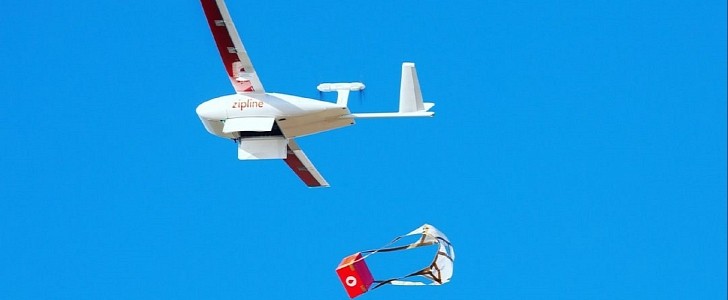From retail to healthcare, Zipline set out to transform aerial mobility with its automated, on-demand drone delivery service, boasting of having made over 300,000 commercial drops so far. And it plans to reach even greater heights with its business, thanks to its newly unveiled DAA (Detection and Avoidance) technology.
Zipline’s Detection and Avoidance system uses onboard acoustic-based tech to enable drones to fly safely even in the most complex, uncontrolled airspaces. A series of small, lightweight acoustic microphones and onboard processors help the UAV (unmanned aerial vehicle) to navigate the airspace, offering 360-degree awareness and working within a range of up to 2,000 m (6,560 ft).
Using the DAA system, the drone can autonomously monitor its surroundings, detecting any other aircraft and adapting to any necessary changes in its flight path. Zipline CTO, Keenan Wyrobek, proudly describes the acoustic system as the holy grail for drone technology, being able to think for itself and adjust in real-time. The hardware has already been built into its drones and is ready to be activated for use in multiple locations upon regulatory approval.
Zipline claims its acoustic detection and avoidance system is a reliable solution for aircraft flying beyond the visual line of sight (BVLOS) and has the power to unlock instant drone delivery at scale in the United States. The company is confident that its onboard DAA will become the industry standard for all commercial autonomous aircraft to fly safely.
What makes Zipline’s acoustic system stand out is the fact that it is lightweight, accurate, and affordable. By comparison, similar existing tech is bulky and relies on ground-based systems for optical or electromagnetic awareness. According to the drone operator, the latter is not optimal for scaling small, long-range drone operations.
Zipline launched its first commercial operations more than five years ago. Nowadays, it claims to make a delivery every four minutes, using its autonomous aircraft that can fly up to 50 miles (80 km) on a charge. Its drones feature a built-in navigation system that helps them figure out their position in three-dimensional space, to an accuracy of up to 0.3” (one centimeter).
Using the DAA system, the drone can autonomously monitor its surroundings, detecting any other aircraft and adapting to any necessary changes in its flight path. Zipline CTO, Keenan Wyrobek, proudly describes the acoustic system as the holy grail for drone technology, being able to think for itself and adjust in real-time. The hardware has already been built into its drones and is ready to be activated for use in multiple locations upon regulatory approval.
Zipline claims its acoustic detection and avoidance system is a reliable solution for aircraft flying beyond the visual line of sight (BVLOS) and has the power to unlock instant drone delivery at scale in the United States. The company is confident that its onboard DAA will become the industry standard for all commercial autonomous aircraft to fly safely.
What makes Zipline’s acoustic system stand out is the fact that it is lightweight, accurate, and affordable. By comparison, similar existing tech is bulky and relies on ground-based systems for optical or electromagnetic awareness. According to the drone operator, the latter is not optimal for scaling small, long-range drone operations.
Zipline launched its first commercial operations more than five years ago. Nowadays, it claims to make a delivery every four minutes, using its autonomous aircraft that can fly up to 50 miles (80 km) on a charge. Its drones feature a built-in navigation system that helps them figure out their position in three-dimensional space, to an accuracy of up to 0.3” (one centimeter).






